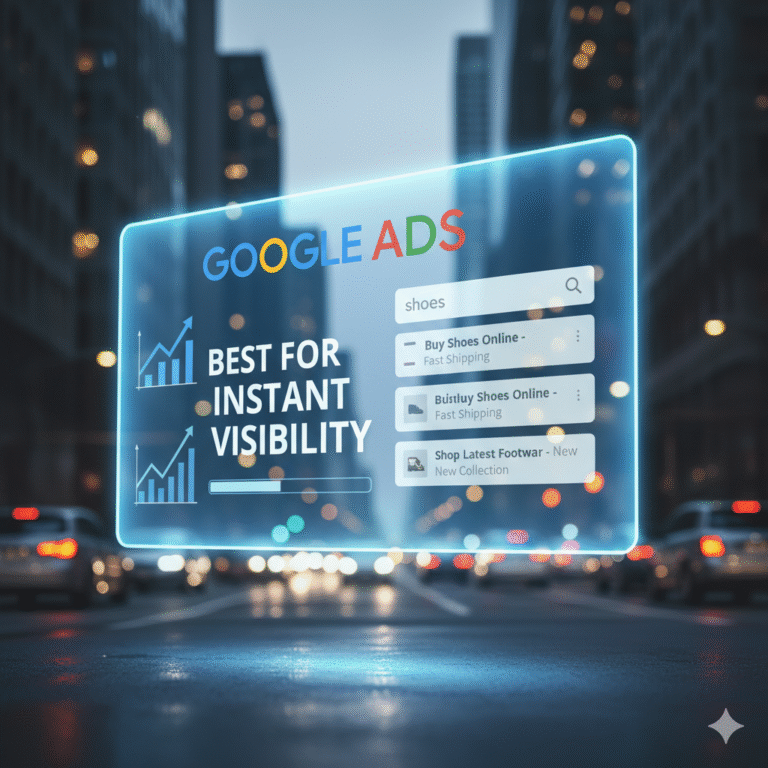I Don’t Know Which Platform Is Right — Google Ads, Meta, or SEO?
Introduction: The Common Dilemma
If you’ve ever asked yourself — “Should I spend on Google Ads, Meta Ads, or SEO?” — you’re not alone.
Most business owners struggle to decide where to invest because every platform promises leads, visibility, and growth.
But the truth is: each platform works differently, and the right one depends on your goals, budget, and timeline.
Let’s break it down clearly so you can make a smart marketing decision that brings real results.
Step 1:Google Ads — Best for Instant Visibility
What It Is:
Google Ads helps you appear at the top of Google search results instantly. It’s a “pay-per-click” model — you pay when someone clicks your ad.
Best For:
Businesses that need leads fast (like hospitals, real estate, or service providers).
Targeting people who are already searching for your product/service.
Pros:
Instant traffic and visibility
Target by keyword, location, and device
Easy to measure ROI
Cons:
Can get expensive if not managed well
Stops working the moment you stop paying
Example:
A home service company can use Google Ads to appear when someone searches “plumber near me” or “AC repair service.”

Step 2: Meta Ads (Facebook & Instagram) — Best for Brand Awareness & Engagement
What It Is:
Meta Ads (on Facebook and Instagram) let you target people based on their interests, demographics, and behavior — not just what they search for.
Best For:
Businesses wanting to build brand awareness
Promoting offers, events, or visual content
Reaching audiences who might not be searching but could be interested
Pros:
Great for storytelling and visual impact
Precise audience targeting
Budget-friendly for testing
Cons:
Users are not actively searching — so lower intent
Results can vary depending on ad design and audience
Example:
A clothing store or restaurant can use Instagram Ads to show their latest collection or menu to nearby users.
Srep 3: SEO (Search Engine Optimization) — Best for Long-Term Growth
What It Is:
SEO helps your website rank organically on Google — without paying for every click. It’s about optimizing your site and content for search engines.
Best For:
Businesses focused on long-term lead generation
Local businesses that want to appear in Google Maps results
Companies building online authority
Pros:
Free, consistent traffic over time
Builds credibility and trust
Works 24/7
Cons:
Takes time (3–6 months for strong results)
Requires consistent updates and quality content
Example:
A hospital or marketing agency can use SEO to rank for keywords like “best hospital in Pune” or “digital marketing agency near me.”
Step 4: Which One Should You Choose?
It depends on your business goal
Goal
Need leads quickly
Build brand awareness
Long-term growth & free leads
Complete growth strategy
Best platform
Google Ads
Meta Ads
SEO
All three combined
Pro Tip: The best results come from combining these platforms strategically:
Use Google Ads for instant visibility
Use Meta Ads for retargeting and awareness
Use SEO to build long-term authority and reduce ad costs over time
Step 5: The Smartest Strategy: Integration
Instead of picking one platform, create a multi-channel strategy:
SEO brings organic visitors.
Google Ads captures high-intent searchers.
Meta Ads keeps your brand visible and nurtures leads.
This mix ensures consistent traffic, trust, and conversions — even when one channel fluctuates.
Conclusion: Don’t Guess — Get a Strategy That Works
Marketing isn’t about choosing one platform — it’s about knowing how they work together.
If you’re still unsure where to start, don’t waste more time guessing.
Let Web Touter create a custom digital strategy that fits your goals, budget, and audience.
Book your free consultation today at https://webtouter.com
